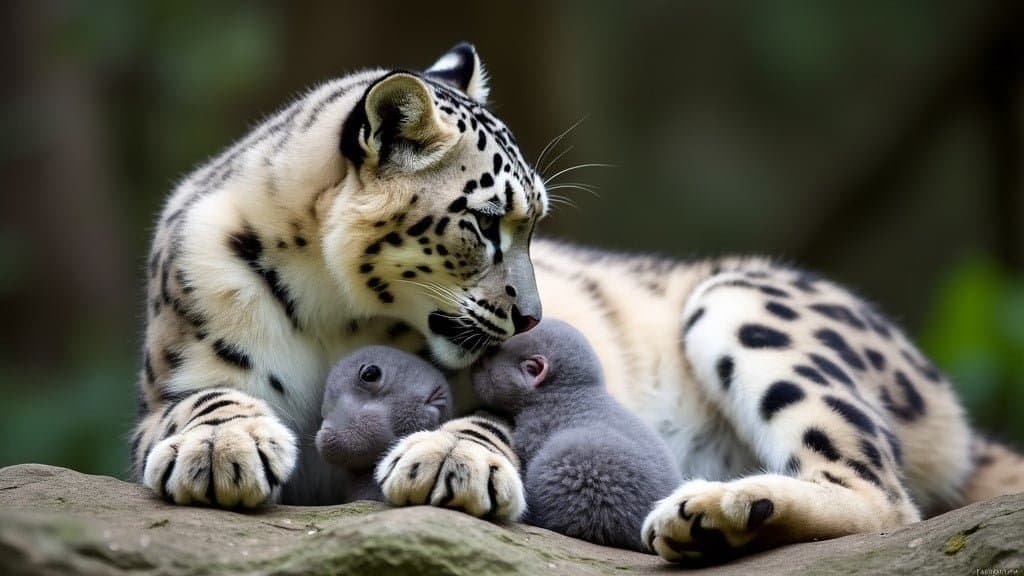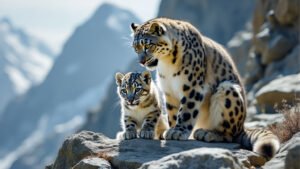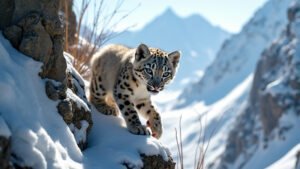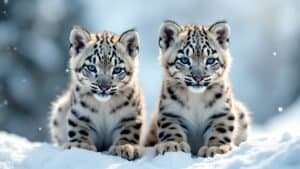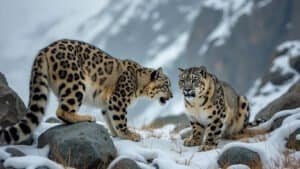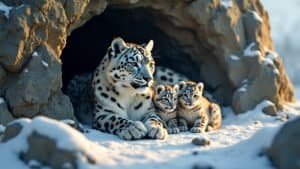Introduction
The gestation period of snow leopards is a critical aspect of their reproductive cycle, influencing the survival and development of this endangered species. This article delves into the intricacies of snow leopard pregnancy, from its duration and stages to the challenges faced by pregnant females
We will explore how many cubs snow leopards typically have, their survival rates, and how mothers care for their young. Additionally, we will discuss the various threats that impact snow leopard pregnancies and the efforts made by researchers to study and conserve this majestic big cat
Understanding Snow Leopard Gestation
Snow leopards, scientifically known as Panthera uncia, are fascinating creatures known for their elusive nature and incredible adaptation to high-altitude environments. Their gestation period is a vital component of their reproductive cycle, ensuring the continuation of the species in their harsh mountainous habitats
The Average Length of Pregnancy
The gestation period for snow leopards typically lasts between 90 to 100 days, approximately three to three and a half months
This duration is relatively short compared to some other large cats but is well-suited to their specific environmental conditions and the survival strategies they have developed
Factors Influencing Gestation Period
Several factors can influence the length of a snow leopard’s gestation period, including:
Health and Nutrition: The overall health and nutritional status of the female can impact the length of pregnancy. Well-nourished females with access to adequate food resources may have slightly shorter gestation periods compared to those in poorer health or with limited food availability
Age of the Female: Younger and older females might experience slight variations in gestation length compared to those in their prime reproductive years
Environmental Conditions: Extreme weather and environmental stressors can affect pregnancy. For instance, harsh winters or unusually warm conditions might influence the hormonal balance and pregnancy duration
Comparison with Other Big Cats
Snow leopards’ gestation periods are relatively short when compared to other big cats:
Tigers: The gestation period for tigers is approximately 104 to 106 days
Lions: Lions have a gestation period of around 110 days
Leopards: The gestation period for leopards is about 90 to 105 days
This comparison highlights that snow leopards have one of the shorter gestation periods among big cats, possibly an adaptation to their high-altitude, cold environments where shorter pregnancies might reduce the risk of complications due to environmental factors
Health and Nutrition
A snow leopard’s diet primarily consists of wild sheep and goats, which are abundant in their mountainous habitats
Adequate prey availability is crucial for pregnant females to maintain good health and support fetal development. Nutritional deficiencies or fluctuations in prey populations can lead to extended gestation periods or impact the health of the cubs
Age of the Female
Reproductive age in snow leopards ranges from about three to ten years. Younger females, those experiencing their first pregnancies, might have longer gestation periods due to physiological immaturity. Conversely, older females might also experience irregularities due to aging reproductive systems
Environmental Conditions
The rugged, high-altitude environments inhabited by snow leopards present unique challenges
Extreme cold, scarcity of prey during certain seasons, and human disturbances can all influence pregnancy. Pregnant females often seek secluded, sheltered areas to give birth, away from potential threats and environmental stressors
Adaptations to High-Altitude Environments
Snow leopards have evolved several adaptations to thrive in their cold, mountainous habitats
Their thick fur, long tail, and powerful limbs are not just for hunting but also for surviving the gestation and rearing of cubs in these conditions. These adaptations also play a role in ensuring successful pregnancies by providing the necessary warmth and protection
Stages of Snow Leopard Pregnancy
Snow leopard pregnancies are divided into distinct stages, each critical to the development of the cubs. Understanding these stages helps in comprehending the reproductive cycle and the unique challenges faced by snow leopards
Early Pregnancy
The early stage of snow leopard pregnancy involves fertilization and the initial development of the embryos. This period is crucial for ensuring the embryos implant successfully in the uterine wall:
Fertilization and Implantation: After mating, which usually occurs between January and mid-March, fertilization takes place. The fertilized eggs travel to the uterus and implant into the uterine lining
Embryonic Development: During the first few weeks, the embryos begin to develop. This stage is marked by rapid cell division and differentiation, forming the basic structures of the future cubs
Mid Pregnancy
Mid pregnancy is a critical phase where the embryos grow and develop more defined features. This stage is essential for the viability and health of the cubs:
Organ Development: Major organs and systems start to form during mid pregnancy. The heart, lungs, and other vital organs begin to develop, preparing the cubs for life outside the womb
Growth and Nourishment: The embryos continue to grow rapidly, receiving nutrients from the mother through the placenta. Adequate nutrition is vital during this stage to ensure proper development
Hormonal Changes: The mother’s body undergoes hormonal changes to support the pregnancy, including increased levels of progesterone to maintain the uterine lining and prevent contractions
Late Pregnancy
The final stage of pregnancy is preparation for birth. The cubs are now well-developed and continue to grow in size and strength:
Final Growth Spurts: In the last few weeks, the cubs undergo significant growth spurts, gaining weight and developing fur. This fur is crucial for their survival in the cold mountainous regions
Nesting Behavior: The mother starts preparing a den or a secluded area where she will give birth. This nesting behavior is essential for providing a safe and sheltered environment for the newborns
Physical Changes in the Mother: The mother’s abdomen becomes noticeably larger, and she may become less active as she conserves energy for the birthing process
Birth and Immediate Post-Birth
The birth of snow leopard cubs is a significant event, marking the culmination of the pregnancy stages:
Labor and Delivery: Labor typically lasts several hours, with the mother giving birth to a litter of 1 to 5 cubs, though 2 to 3 is most common. The cubs are born blind and helpless, relying entirely on their mother for warmth and nutrition
First Few Hours: Immediately after birth, the mother cleans the cubs and stimulates their breathing. The cubs begin nursing within hours, receiving colostrum, which is rich in antibodies to protect them from infections
Survival and Early Development
The initial days and weeks after birth are critical for the survival and development of the cubs:
Maternal Care: The mother stays close to her cubs, nursing them frequently and keeping them warm. Her presence is crucial for their survival during this vulnerable period
Growth Milestones: The cubs start to open their eyes after about 7 to 10 days and begin exploring their surroundings within a month. They gradually gain strength and coordination, essential for their survival in the wild
Birth and Development of Cubs
The birth and early development of snow leopard cubs are critical to the survival and continuity of the species. This section explores the typical litter size, survival rates, and maternal care that contribute to the growth and eventual independence of the cubs
Typical Litter Size
Snow leopards usually give birth to 1 to 5 cubs per litter, with 2 to 3 being the most common:
Influence of Environmental Conditions: The number of cubs can be influenced by environmental factors such as food availability and the mother’s health. In years with abundant prey, females may give birth to larger litters
Comparison with Other Big Cats: Compared to other big cats, snow leopards have relatively small litters. For example, lions and tigers can have litters of up to 6 cubs, while leopards generally have 2 to 3 cubs per litter
Survival Rate of Cubs
The survival rate of snow leopard cubs is influenced by several factors, including environmental conditions, predation, and maternal care:
High Mortality Rates: Unfortunately, cub mortality rates are high. Studies indicate that only about 50% of snow leopard cubs survive their first year. This high mortality rate is due to factors such as harsh weather, scarcity of prey, and predation
Maternal Influence: The survival of the cubs is highly dependent on the mother’s ability to provide adequate nutrition and protection. Mothers must hunt frequently and defend their cubs from potential threats
Care of Cubs After Birth
The care provided by the mother is essential for the growth and development of the cubs:
Nursing and Nutrition: Cubs are born blind and helpless, relying entirely on their mother for nourishment. They begin nursing immediately after birth and continue to nurse for several months. The mother’s milk provides essential nutrients and antibodies to protect the cubs from diseases
Protection and Shelter: The mother chooses a well-sheltered den for giving birth and rearing her cubs. This den provides protection from the elements and predators. The mother stays with her cubs, leaving only briefly to hunt
Teaching Survival Skills: As the cubs grow, the mother begins to teach them essential survival skills, such as hunting and navigating their mountainous terrain. This training is crucial for their future independence
Growth Milestones
The early months of a snow leopard cub’s life are marked by several important milestones:
Opening Eyes and Mobility: Cubs open their eyes around 7 to 10 days after birth. They start to move around the den and explore their surroundings within the first month
Weaning and Diet Transition: Cubs begin to eat solid food at around 2 months old, although they continue to nurse. The mother starts bringing prey to the den for the cubs to practice hunting and feeding
Learning to Hunt: By the age of 3 months, cubs start accompanying their mother on hunting trips. They observe and learn from her techniques, gradually becoming more proficient hunters
Independence
The path to independence is gradual, with cubs becoming fully independent around 18 to 24 months old:
Increasing Independence: As they grow, cubs spend more time away from the den and become more independent. They practice hunting and start making their own kills
Separation from Mother: Around 18 to 24 months, cubs leave their mother to establish their own territories. This separation is crucial for preventing inbreeding and ensuring the genetic diversity of the population
Survival Challenges: Young snow leopards face numerous challenges as they establish their independence, including finding territory, competing for prey, and avoiding predators. The skills learned from their mother are vital for their survival
Challenges During Snow Leopard Pregnancy
Snow leopard pregnancies are fraught with challenges that can affect the health and survival of both the mother and her cubs. These challenges stem from environmental threats, health issues, and human impacts that snow leopards face in their natural habitats
Environmental Threats
The harsh, mountainous environments that snow leopards inhabit present significant challenges during pregnancy:
Extreme Weather: Snow leopards live in some of the world’s most rugged and coldest environments, with temperatures dropping well below freezing. Extreme cold can stress pregnant females, affecting their health and the development of their cubs
Scarcity of Prey: The availability of prey fluctuates seasonally and geographically. During winter, prey may become scarce, forcing pregnant snow leopards to travel longer distances to find food, which can lead to malnutrition and lower birth weights for cubs
Natural Predators: While adult snow leopards have few natural predators, their cubs are vulnerable to predation from other large carnivores and birds of prey. Pregnant females must find secure den sites to protect their newborns
Health Issues
Health problems can significantly impact the success of snow leopard pregnancies:
Nutritional Deficiencies: A diet lacking in essential nutrients can lead to complications during pregnancy. Adequate nutrition is critical for the development of healthy cubs and the mother’s ability to nurse them
Injuries and Illnesses: Snow leopards are prone to injuries from hunting or territorial disputes. Illnesses, both from infections and genetic conditions, can also affect pregnant females and their ability to carry to term successfully
Parasites and Diseases: Internal and external parasites, as well as diseases, can compromise the health of pregnant snow leopards. Veterinary studies have documented various parasitic infections that can lead to poor health outcomes for both mother and cubs
Human Impact
Human activities have a profound effect on snow leopard pregnancies and their overall survival:
Habitat Destruction: Expansion of human settlements, agriculture, and infrastructure projects encroach on snow leopard habitats, reducing the availability of prey and safe birthing sites. This habitat fragmentation forces snow leopards into closer proximity with humans, increasing the risk of conflict
Poaching and Illegal Trade: Snow leopards are hunted for their fur and bones, which are highly valued in illegal wildlife trade. Pregnant females are particularly vulnerable to poaching, and the loss of breeding individuals severely impacts population sustainability
Climate Change: Global warming alters the snow leopards’ habitat, affecting prey availability and weather patterns. Changes in snowfall and temperature can disrupt the delicate balance of the ecosystems they depend on, making it harder for pregnant females to find food and shelter
Conservation Efforts
Various conservation initiatives aim to mitigate the challenges faced by snow leopards during pregnancy:
Protected Areas: Establishing and maintaining protected areas where snow leopards can live and breed safely is crucial. These areas help preserve the natural habitat and reduce human-wildlife conflicts
Anti-Poaching Measures: Strengthening anti-poaching laws and enforcement helps protect pregnant snow leopards from illegal hunting. Community education and alternative livelihood programs for local people reduce poaching incentives
Research and Monitoring: Ongoing research and monitoring of snow leopard populations help identify critical threats and inform conservation strategies. GPS collars and camera traps provide valuable data on snow leopard movements and reproductive success
Climate Action: Efforts to combat climate change, such as reducing greenhouse gas emissions and protecting carbon sinks, indirectly benefit snow leopards by preserving their habitats
Research on Snow Leopard Reproduction
Research on snow leopard reproduction is crucial for understanding their biology, behavior, and the challenges they face. This knowledge informs conservation efforts and helps develop strategies to protect this endangered species
Methods of Study
Studying snow leopards in the wild presents unique challenges due to their elusive nature and harsh habitats:
Radio and GPS Collaring: Researchers use radio and GPS collars to track the movements and behaviors of snow leopards. These collars provide valuable data on their range, mating habits, and denning sites
Camera Traps: Strategically placed camera traps capture images and videos of snow leopards, offering insights into their reproductive behavior, litter size, and cub development. This non-invasive method is particularly useful in remote and difficult-to-access areas
Genetic Sampling: Collecting genetic samples from snow leopard scat, hair, and other biological materials allows researchers to study their population genetics, health, and relatedness. This information helps identify genetic diversity and potential inbreeding issues
Field Observations: Direct observations by field biologists provide detailed information on snow leopard behavior, interactions, and environmental conditions. These observations are often supplemented by community reports from local residents
Key Findings
Research has yielded important insights into snow leopard reproduction and behavior:
Breeding Season: Snow leopards typically mate between January and mid-March. The timing of the breeding season ensures that cubs are born in the spring or early summer when prey is more abundant and weather conditions are less severe
Denning Sites: Pregnant females choose secluded, rocky dens to give birth. These dens provide protection from the elements and predators. Research has shown that females may use the same den sites repeatedly, indicating the importance of these locations for reproductive success
Cub Mortality Rates: Studies have documented high cub mortality rates, with only about 50% of cubs surviving their first year. Factors such as predation, harsh weather, and food scarcity contribute to these high mortality rates
Maternal Behavior: Research indicates that snow leopard mothers are highly protective and attentive to their cubs. They spend extended periods in the den with their cubs, minimizing the time spent away to hunt
Conservation Efforts
Research findings are directly applied to conservation strategies aimed at protecting snow leopards and their habitats:
Protected Habitats: Identifying and securing critical habitats, such as denning sites and prey-rich areas, is essential. Conservation organizations work to establish and manage protected areas to ensure safe breeding grounds for snow leopards
Community Involvement: Engaging local communities in conservation efforts is crucial. Programs that promote coexistence between humans and snow leopards, such as livestock insurance schemes and alternative livelihood projects, help reduce human-wildlife conflicts
Anti-Poaching Initiatives: Research highlights the impact of poaching on snow leopard populations. Strengthening anti-poaching laws, increasing patrols, and providing education on the importance of snow leopards are vital steps in reducing illegal hunting
Climate Adaptation: Understanding the effects of climate change on snow leopard habitats helps develop strategies to mitigate these impacts. Conservationists work on climate adaptation projects that support ecosystem resilience and ensure the availability of prey
Technological Advances
Advancements in technology have enhanced research capabilities and conservation efforts:
Drones: Drones are increasingly used to monitor snow leopard habitats, providing aerial views of remote areas. This technology helps locate dens, track movements, and assess environmental conditions
Satellite Imagery: High-resolution satellite imagery assists in mapping snow leopard territories and identifying changes in land use and habitat quality. This information is crucial for planning conservation interventions
Genomic Studies: Advances in genomics allow for more detailed analysis of snow leopard genetics. These studies help identify genetic health issues, inform breeding programs, and understand evolutionary adaptations
Conclusion
Snow leopards are remarkable creatures with unique reproductive strategies adapted to their harsh mountainous environments. Their gestation period of approximately 90 to 100 days, influenced by factors such as health, nutrition, and environmental conditions, is relatively short compared to other big cats
The stages of pregnancy—from early to late—are critical for the development and survival of cubs, who face high mortality rates due to environmental threats and scarcity of prey
The challenges during snow leopard pregnancies, including extreme weather, health issues, and human impacts such as habitat destruction and poaching, underscore the fragility of their existence. However, through various research methods like GPS collaring, camera traps, and genetic sampling, scientists have gained valuable insights into their reproductive behavior and maternal care
These findings have informed effective conservation efforts, including the establishment of protected areas, community involvement, and anti-poaching initiatives
Technological advancements like drones, satellite imagery, and genomic studies further enhance our understanding and protection of snow leopards. By addressing the multifaceted challenges they face and continuing robust research and conservation efforts, we can help ensure the survival of this majestic and endangered species
